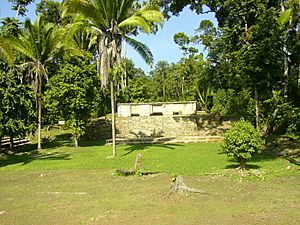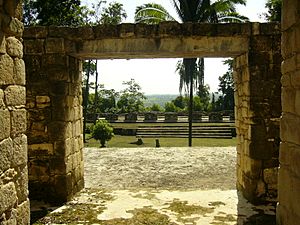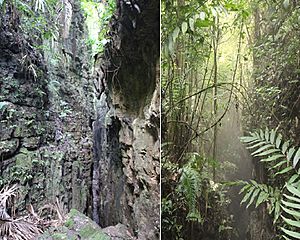Aguateca facts for kids
| Lua error in Module:Wikidata at line 70: attempt to index field 'wikibase' (a nil value).
The main plaza of Aguateca showing a large stone stela
|
|
| Lua error in Module:Location_map at line 420: attempt to index field 'wikibase' (a nil value). | |
| Region | Petén Department, Guatemala |
|---|---|
Aguateca was an important ancient Maya city. It is located in northern Guatemala, in a region called the Petexbatun Basin. People first settled here around 300 BC.
The city was lived in from about 200 BC until around 800 AD. At that time, the city was suddenly attacked and left empty. Because people left so quickly, many everyday items were left behind. This is similar to what happened in the Roman city of Pompeii. These discoveries help us learn a lot about how the Maya lived.
Aguateca was built on top of a very tall limestone cliff, about 90 meters (295 feet) high. This made it a very strong place to defend. The cliff overlooks the Petexbatun Lagoon. You could only reach the city by boat. The city also had a huge system of defensive walls, over 3 miles (5 km) long.
The main part of Aguateca included the Palace Group, which was likely where the royal family lived. There was also a large Main Plaza. A raised pathway, called a causeway, connected these areas. Many important people lived along this pathway. The city was burned during the rule of Tan Te' K'inich and completely abandoned around 830 AD.
An unfinished temple, 6 meters (20 feet) tall, shows how quickly the city was left. Valuables were scattered in homes, and pottery was left in place. All these signs point to a very sudden departure. Today, the ruins of Aguateca are some of the best preserved in Guatemala.
Contents
Becoming a Big City
Aguateca and the nearby city of Dos Pilas were like twin capitals. They were ruled by a powerful family who said they came from the rulers of Tikal. Around 700 AD, the rulers of Dos Pilas started focusing more on Aguateca. This is shown by stone monuments found at the sites.
By 761 AD, the rulers of Dos Pilas seemed to have moved completely to Aguateca. Aguateca grew into a large city with many buildings. It had more structures packed together than most other Maya cities in the lowlands. Many people likely moved to Aguateca from other areas. This was probably because of the ruling family's power. Building a new city with temples, palaces, and roads needed a lot of workers. It was important for the royal family to have a large, controlled population.
Buildings and Daily Life
The buildings at Aguateca have given archaeologists great clues. They help us understand how society was organized. We can learn about different social classes and their daily routines. Studying these homes helps us understand how people lived and behaved.
Homes of Important People
In ancient societies like Aguateca, home life and public life were often mixed. This is different from today, where "home" and "work" are usually separate.
Homes in the important residential areas of Aguateca often had three main rooms. They also had smaller additions. These homes contained many everyday items. These included serving dishes, grinding stones, and stone tools. Archaeologists also found obsidian blades, possibly used for bloodletting. Stone mortars for preparing colors were also found.
The main rooms seemed to be for meeting guests or for scribes to work. They also stored special religious items and food. Grinding tools like mano and metate were found in some main rooms. This shows that food was prepared there. In one room, seven bone needles and seven spindle whorls were found. This suggests that people made textiles in or near this room. This was likely a task done by women.
Important residents did many daily activities in their homes. This included storing, preparing, and eating food. These homes were also places for political meetings and creating art. A man might use the central room for meetings and a side room for writing or art. The other room was probably used by women.
Each home served many purposes. No buildings were found that were only for storing food. This means food storage was not controlled by a central power. Differences in food storage might show differences in family size or wealth. An important Maya man might do many things. He could carve stone, wood, shell, or bone. He also had duties like managing, diplomacy, and religious tasks. Important Maya women might create art and crafts. They also did other household activities. Important Maya men and women had many different roles in society.
The Main Plaza and Shows
The ancient Maya loved big performances and showing off their rulers. The large plaza at Aguateca was built to hold many people. Most community members gathered here for special ceremonies. People worked hard to create spaces for large shows. They built plazas outside the main areas and made big causeways. Important statues of rulers were also placed in the plazas.
These shows probably helped bring the Maya community together around their ruler. The different sizes of plazas suggest that some shows were only for special people. This separated the privileged from others.
The Palace Group and Royal Family
The Palace Group was the royal palace. Its layout and the items found there show its special importance. These buildings also served as offices. The central rooms were used for royal meetings and other political gatherings. The design of the palace allowed the ruler to be seen. For example, meetings in some palace buildings could be seen by those not allowed inside. Maya paintings on pottery often show meeting scenes. This suggests that some royal gatherings were meant to be watched. It seems the royal family cleaned out the palace rooms before the final attack. They left the city center, expecting to return.
Building Temples and Common People
Archaeologists found an unfinished temple. It was still being built when the city was attacked and abandoned in the early 9th century. This discovery gives us valuable information about Maya building methods. It also shows that people likely had special jobs.
Construction workers might have been organized into different groups. Some carried rocks, others cut stones. Masons set stones with mortar, and sculptors carved monuments. All these people worked together. Important architects or supervisors probably managed everyone's tasks.
What They Made and Used
Important Artists
Many important Maya people, both men and women, created art and crafts at Aguateca. They made luxury items and weapons. They also made everyday items for use in their homes and for trade. These items included wood carvings and leather goods. Different types of crafts were made in various homes. However, some homes focused on specific art or craft activities.
One home might carve stelae (tall stone monuments) for the ruler. Another might focus on shell and bone objects with special meanings. It is likely that important women helped with stone carving alongside noble men. Creating art and having special knowledge was important for showing who was important. Some of these important art pieces were found burned after Aguateca was abandoned. Pieces representing "The Jester God" were found in one important home. This shows how important art was to the elite.
Obsidian Stone
Obsidian was a very valuable material in Classic Maya society. Owning it showed high status. The rulers of Aguateca controlled who could get obsidian in the city. The royal court probably managed how obsidian was obtained and shared. Rulers and important scribes/artists had more and stronger obsidian blades than those in smaller homes. The presence of obsidian also shows that the Maya at Aguateca traded with distant regions.
Animals and Their Uses
Making goods from animal products for the community and rulers was common. Everyone in the community was involved in some way. But some crafts were only done in specific homes. Activities included producing meat and hides, and making bone tools. Some animals were luxury goods and foods. Access to these depended on a person's social rank.
The upper class had more access to animals considered special or exotic. These included marine shells for decoration. They also had wild cats like jaguars, margays, and ocelots. These were used for their fur, teeth, and claws. Common animals were also used for food and tools. Animals often eaten at Aguateca included white-tailed deer, river turtles, dogs, agouti, paca, peccaries, large birds, and river fish.
Theatre and Performances
The Main Plaza at Aguateca had many stone monuments. It was a perfect place for theatrical performances. These shows didn't just share old ideas. They also helped create the political reality that people experienced. Theatrical events were important for bringing people together and for managing conflicts. They had a big effect on how societies were kept together and changed.
Performances by rulers, shown on stone monuments, involved many people. This makes the Main Plaza at Aguateca very important. Its use as a theater space was a main concern when the city was designed. These events made the community feel real. They also helped keep people from moving away from the city center. Important people might have used these shows to push their political ideas. But they were also constantly judged by the audience. Theatrical events set the stage for creating and enforcing power and beliefs. They also allowed for resistance against them.
Tools They Used
To make all their goods and materials, the people of Aguateca had to create their own tools. Some of these tools included manos and metates. These were grinding tools. Manos were typically used for preparing corn. Metates were used to grind other materials into smaller pieces.
Some animal products were also used as tools. For example, deer bones helped in making stone tools and polishing. The people of Aguateca made these tools. These tools then helped them create many other items found at the ancient site. This helps us understand how they organized and carried out their production of materials and goods.
Main Chasm Rituals
The Main Chasm is a natural, deep crack in the limestone rock. It runs through the middle of the Aguateca site. It is about 850 meters (2,789 feet) long, 10–70 meters (33–230 feet) deep, and 1.5–15 meters (5–49 feet) wide. The Maya saw chasms like caves. They believed these were powerful religious places where they could reach spirits.
Evidence shows many ritual practices happened here. This suggests that chasms, like caves, were important places. They were where people could connect with ancestors and supernatural spirits. The features of the Main Chasm at Aguateca show how the Maya used the power of nature. They hoped to bring rain by playing wind instruments and burning fires. These fires might have included copal incense, which would create black smoke. This smoke looked like rain clouds, hoping to bring real rain. The Maya believed that air (wind) and water (rain) were closely connected. Water was essential for life. Rain ceremonies had many meanings, from enough rainfall to the prosperity of the ruling family. The Maya symbol for Aguateca even represents the chasm.
Farming Life
Farming at Aguateca, like other Maya sites, was challenging. They had shallow, sloped soils and unpredictable weather. This was true until their collapse. By studying carbon in the soil, we can tell that corn (maize) was grown there.
The ancient Maya of Aguateca probably farmed in the best areas. It is likely that corn was grown in the seasonal wetlands next to the site. Natural sinkholes called "rejollada" and "toeslip" soils were important. Seasonally flooded wetlands also had deep, fertile soils. The stepped slopes of the rejolladas might have acted like natural terraces for farming. These areas were probably used often for growing corn and may have been politically important.
War and Weapons
Both the royal family and important scribes/artists at Aguateca used spears and darts. They used these for fighting other groups. They also used them for making art and crafts when enemies were a threat. The ruler and important people were also warriors. Owning these weapons and fighting in wars helped them stay in power.
Spears and darts were more important than bows and arrows. However, marks on the points show that bows and arrows were also used. Fighting between different groups may have been a key reason why complex Maya societies like Aguateca developed. This warfare had a big impact on society. It was also what eventually led to Aguateca's downfall.
The End of Aguateca
Towards the end of Aguateca's rule, fighting between groups, climate changes, and environmental problems caused social unrest. But the final destruction of the city was due to warfare. Around 800 AD, Aguateca seems to have been attacked by enemies. A series of defensive walls were quickly built around that time. This was probably in response to more fighting in the region.
The important residential area near the royal palace was burned. Residents either fled or were taken away, leaving most of their belongings behind. The attacking army did not stay in the city center. Soon, the entire city was abandoned. Fancy buildings like the Palace Group had very valuable items. These included greenstone beads, carved alabaster, and shell decorations. This further supports that the city was abandoned very quickly.
Excavations at the Palace Group suggest the royal family left the center before the attack. They expected to return. But it seems some important people stayed behind. Areas outside the city center were abandoned slowly. This probably happened right after the city was destroyed. The people living there took most of their belongings with them.
Because of how the destruction and abandonment happened, it seems the main target of the battle was Aguateca's ruling elite. The enemies wanted to end Aguateca's power, and they succeeded. The sudden fall of Aguateca is very similar to what happened in Pompeii. This gives us a lot of evidence today. Moments of ancient Maya life were "frozen" in time. The many objects left in the burned buildings provide information about daily activities, how homes were organized, and political interactions of the Classic Maya at Aguateca.
Known Rulers
See Also
 In Spanish: Aguateca para niños
In Spanish: Aguateca para niños





